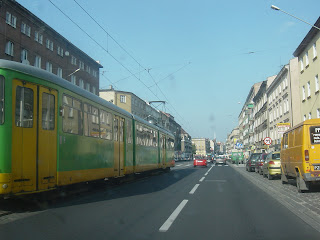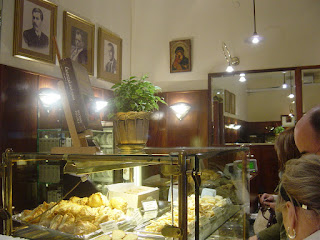Leaving Germany and crossing into Poland, we encountered Polish immigration. The young officer at the border questioned me extensively about our purpose for visiting the country. I had to present my road trip itinerary and all our hostel bookings before he would grant us passage. Despite his cautious demeanor, he remained cordial throughout the interaction.
Our drive into Warszawa (Warsaw) proved unpleasantly long and tiring, severely hampered by extensive road constructions that bottlenecked traffic into single-lane backlogs. Sitting in bumper-to-bumper traffic with a full bladder was certainly no fun, yet somehow, I made it to the next restroom stop in one piece. We noticed countless trucks traversing Poland - a clear indication that the country needs to improve its land infrastructure significantly, perhaps by building more freeways, to better facilitate the transportation of goods. It's evident that Poland has transformed into a major outsourcing hub for modern Europe.
Poznan offered a welcome respite enroute to Warszawa, where our money stretched remarkably far, a pleasant surprise we found common throughout Poland. There, I exchanged 50 euros for 186 złoty at a rate of 3.72. We were incredibly fortunate, once again, to be assisted by friendly locals at every turn. I'm grateful for their kindness, and I thank God for being with us on this journey.
Warszawa is Europe's 8th largest city according to Wikipedia (2007). Given that much of the Old Town was tragically razed by Hitler during World War II, it was particularly striking to see how faithfully the historic buildings have been reconstructed. These recreated structures, based on archival records and collective memory, stand as powerful symbols of resilience and cultural restoration.
Though no linguist, I noticed that many locals spoke some Russian alongside Polish - perhaps a lingering remnant of past occupations, subtly woven into daily conversations. Food-wise, the offerings were generally simple fare, with a clear national fondness for sweets. At a free rock concert and along the shop-lined streets, I saw many restless youngsters mingling - a scene familiar across cultures.
We stayed two nights at Hostel Tamka for around €104 total.
Above: In Poznan ~ this parking attendant was so friendly
Above: In Warszawa (Warsaw)
Above left: A monument dedicated to renowned astronomer Nicolaus Copernicus, who formulated the heliocentric theory - proposing that the Earth and other planets revolve around the Sun, instead of an Earth-centered universe. He holds an armillary sphere, a symbol of astronomical study. Born in Poland in 1473, Copernicus was a polymath, excelling as an astronomer, physician, economist, and mathematician.
Above left: The Church of the Holy Cross; Above right: "Svrsvm Corda" translates to "Lift up your hearts"
Above right: The Church of the Holy Cross is known for housing Frédéric Chopin’s heart, smuggled back to Poland by his sister after his death in Paris. His heart is preserved inside this pillar. Born in Żelazowa Wola in 1810, Frédéric Chopin carried his Polish heritage with him throughout his life in Paris, expressing a deep affection for his homeland in his music and letters.
Above right: The plaque commemorates several significant anniversaries related to the Church of the Holy Cross. It reads:
"On the 300th anniversary of the consecration of the Church of the Holy Cross
In the 18th year of the pontificate of John Paul II, the Polish Pope
On the 400th anniversary of Warsaw's status as the capital
Grateful to God for the gift of this church
The first Polish establishment of the Congregation of the Missionary Priests of St. Vincent de Paul,
Arrived in Poland in 1651
This plaque is funded by the residents of the capital
Warsaw, 15 October 1998"
Above: Royal Castle Square, Warszawa (A UNESCO World Heritage Site)
Above left: The Royal Castle - a faithful reconstruction of the original 14th-C residence that served as the official home of Polish monarchs after Warszawa became the capital in the late 1500s
Above left: Syrenka Warszawska - the fierce guardian of Warszawa - in the Old Town Market Place
Above: The Warsaw Barbican was originally built in 1540 as part of the city's defensive walls; it was reconstructed in the mid-20th-C
Above: St. John's Archcathedral ~ a Catholic church in the Old Town precinct in Warszawa
Above left: Sigismund’s Column, erected in 1644, honors King Sigismund III Vasa, who relocated Poland’s capital from Kraków to Warszawa in the late 16th century. Destroyed during World War II, it was meticulously reconstructed and now stands proudly in Castle Square.
Above: My parents were absolutely delighted to discover chestnuts, and promptly began gathering more!
Above right: The Monument to the Heroes of Warsaw 1939-1945 stands as a tribute to the bravery and sacrifice of those who fought for the city during World War II.
Above left: Remnants of the historic Warszawa Saxon Palace; Above right: Tomb of the Unknown Soldier, Warszawa
Above: Obwarzanki ~ these bread rings are a beloved street snack in Poland, especially in cities like Kraków and Warszawa. They're often sprinkled with poppy seeds, sesame, or salt.
Above: Dinner at Sphinx Restaurant ~ €21.53
Above right: Back on the road the next morning ~ on our way to Prague
Next post: Prague, the Czech Republic
Previous post: Berlin, Germany































































































No comments:
Post a Comment